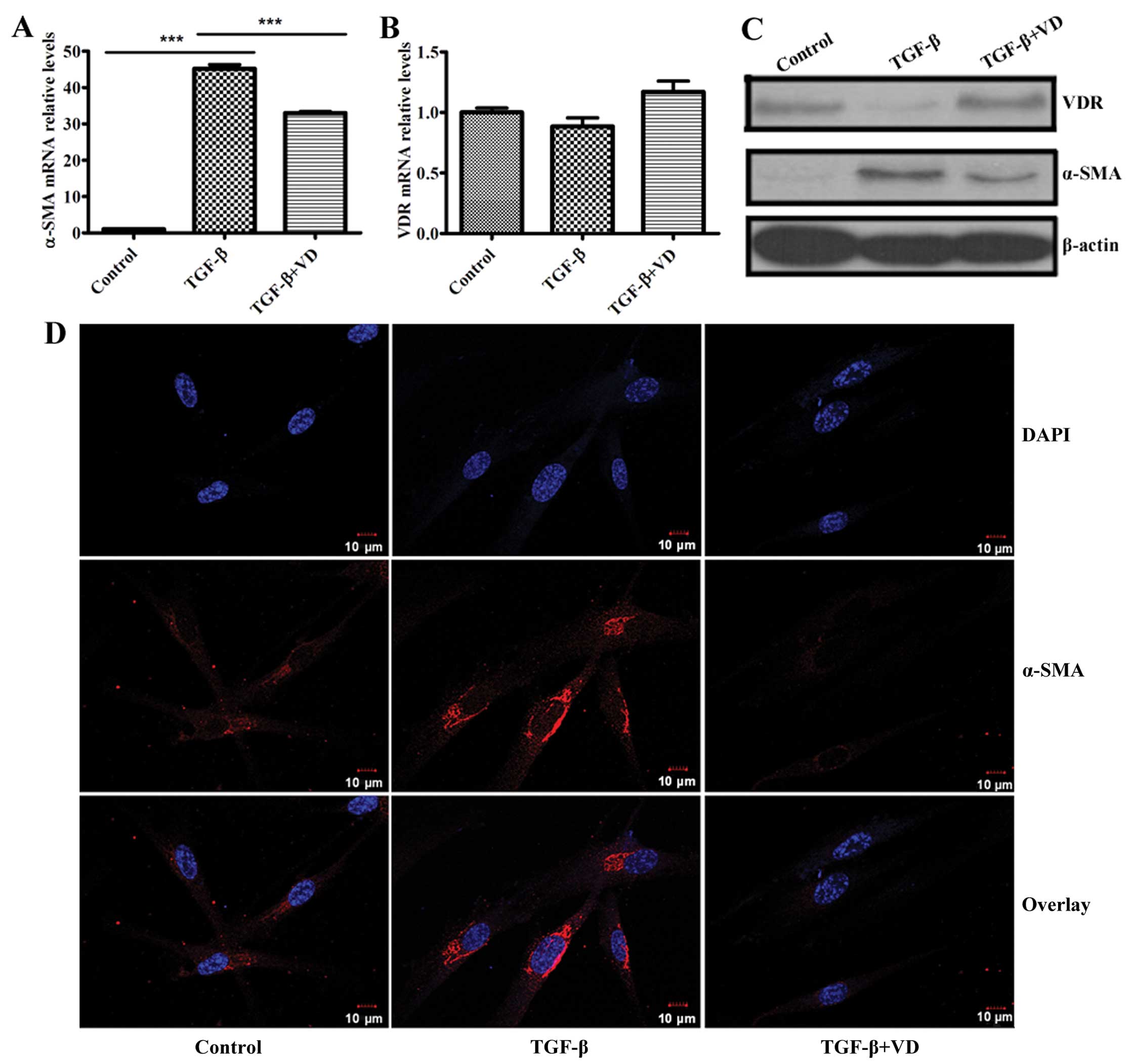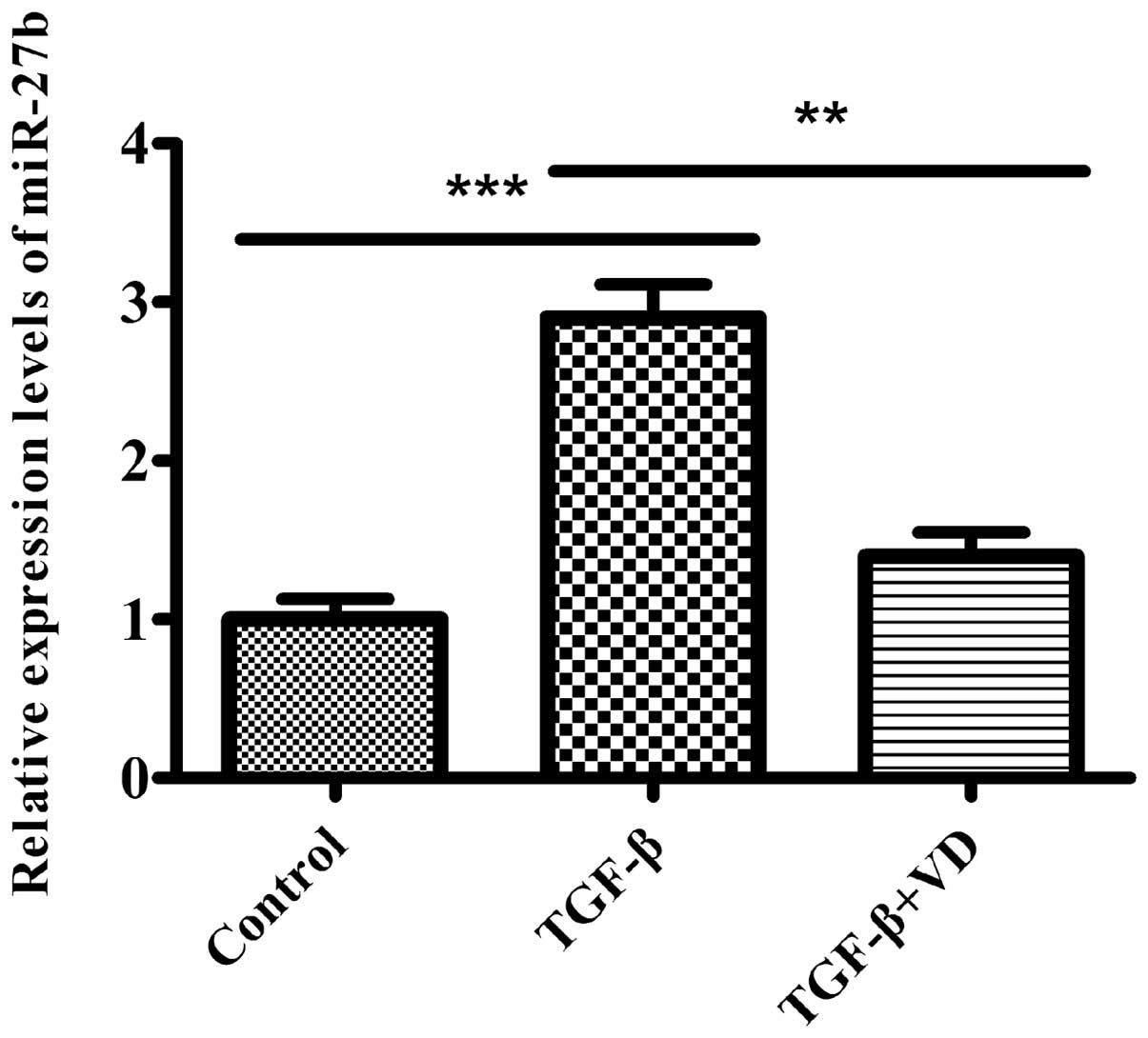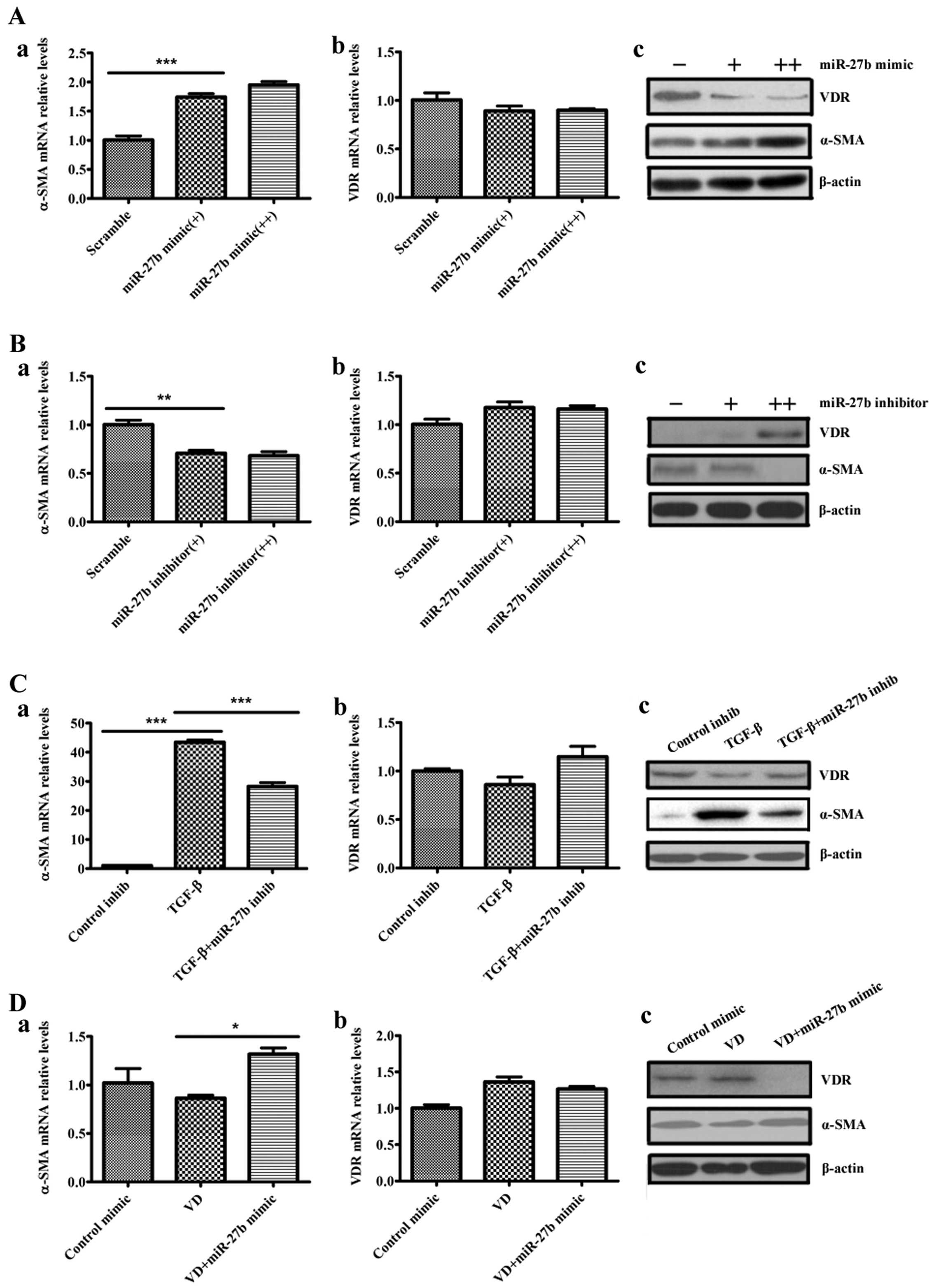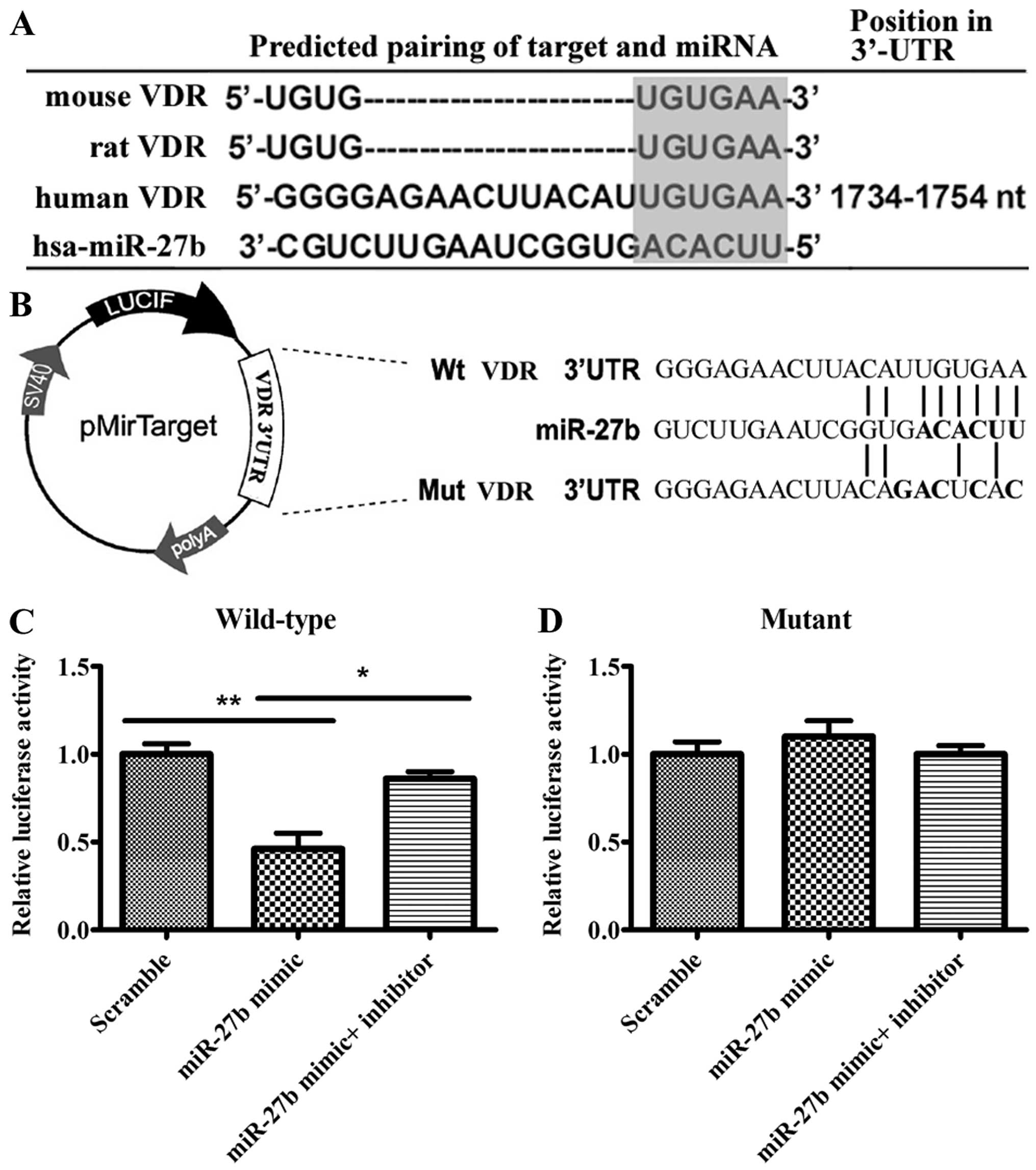|
1
|
Holick MF: Vitamin D deficiency. N Engl J
Med. 357:266–281. 2007. View Article : Google Scholar : PubMed/NCBI
|
|
2
|
van Etten E, Stoffels K, Gysemans C,
Mathieu C and Overbergh L: Regulation of vitamin D homeostasis:
Implications for the immune system. Nutr Rev. 66(Suppl 2):
S125–S134. 2008. View Article : Google Scholar : PubMed/NCBI
|
|
3
|
Haroon M and Fitzgerald O: Vitamin D and
its emerging role in immunopathology. Clin Rheumatol. 31:199–202.
2012. View Article : Google Scholar
|
|
4
|
Messa P, Alfieri C and Rastaldi MP: Recent
insights into vitamin D and its receptor. J Nephrol. 24(Suppl 18):
S30–S37. 2011. View Article : Google Scholar : PubMed/NCBI
|
|
5
|
Førli L, Bjortuft O and Boe J: Vitamin D
status in relation to nutritional depletion and muscle function in
patients with advanced pulmonary disease. Exp Lung Res. 35:524–538.
2009. View Article : Google Scholar : PubMed/NCBI
|
|
6
|
Black PN and Scragg R: Relationship
between serum 25-hydroxyvitamin D and pulmonary function in the
third national health and nutrition examination survey. Chest.
128:3792–3798. 2005. View Article : Google Scholar : PubMed/NCBI
|
|
7
|
Foong RE and Zosky GR: Vitamin D
deficiency and the lung: Disease initiator or disease modifier?
Nutrients. 5:2880–2900. 2013. View Article : Google Scholar : PubMed/NCBI
|
|
8
|
Hansdottir S and Monick MM: Vitamin D
effects on lung immunity and respiratory diseases. Vitam Horm.
86:217–237. 2011. View Article : Google Scholar : PubMed/NCBI
|
|
9
|
Herr C, Greulich T, Koczulla RA, Meyer S,
Zakharkina T, Branscheidt M, Eschmann R and Bals R: The role of
vitamin D in pulmonary disease: COPD, asthma, infection, and
cancer. Respir Res. 12:312011. View Article : Google Scholar : PubMed/NCBI
|
|
10
|
Finklea JD, Grossmann RE and Tangpricha V:
Vitamin D and chronic lung disease: A review of molecular
mechanisms and clinical studies. Adv Nutr. 2:244–253. 2011.
View Article : Google Scholar :
|
|
11
|
Hughes DA and Norton R: Vitamin D and
respiratory health. Clin Exp Immunol. 158:20–25. 2009. View Article : Google Scholar : PubMed/NCBI
|
|
12
|
Demir M, Uyan U, Keçeoçlu S and Demir C:
The relationship between vitamin D deficiency and pulmonary
hypertension. Prague Med Rep. 114:154–161. 2013. View Article : Google Scholar : PubMed/NCBI
|
|
13
|
Lips P: Vitamin D physiology. Prog Biophys
Mol Biol. 92:4–8. 2006. View Article : Google Scholar : PubMed/NCBI
|
|
14
|
Haussler MR, Jurutka PW, Mizwicki M and
Norman AW: Vitamin D receptor (VDR)-mediated actions of
1α,25(OH)2 vitamin D3: Genomic and
non-genomic mechanisms. Best Pract Res Clin Endocrinol Metab.
25:543–559. 2011. View Article : Google Scholar : PubMed/NCBI
|
|
15
|
Duffield JS, Lupher M, Thannickal VJ and
Wynn TA: Host responses in tissue repair and fibrosis. Annu Rev
Pathol. 8:241–276. 2013. View Article : Google Scholar :
|
|
16
|
Hetzel M, Bachem M, Anders D, Trischler G
and Faehling M: Different effects of growth factors on
proliferation and matrix production of normal and fibrotic human
lung fibroblasts. Lung. 183:225–237. 2005. View Article : Google Scholar : PubMed/NCBI
|
|
17
|
Coen M, Gabbiani G, Bochaton-Piallat ML
and Chen YE: Myofibroblast-mediated adventitial remodeling: An
underestimated player in arterial pathology. Arterioscler Thromb
Vasc Biol. 31:2391–2396. 2011. View Article : Google Scholar : PubMed/NCBI
|
|
18
|
Sartore S, Chiavegato A, Faggin E, Franch
R, Puato M, Ausoni S and Pauletto P: Contribution of adventitial
fibroblasts to neointima formation and vascular remodeling: From
innocent bystander to active participant. Circ Res. 89:1111–1121.
2001. View Article : Google Scholar : PubMed/NCBI
|
|
19
|
Liu X, Nelson A, Wang X, Farid M, Gunji Y,
Ikari J, Iwasawa S, Basma H, Feghali-Bostwick C and Rennard SI:
Vitamin D modulates prostaglandin E2 synthesis and degradation in
human lung fibroblasts. Am J Respir Cell Mol Biol. 50:40–50.
2014.
|
|
20
|
Stenmark KR, Frid MG and Yeager ME:
Fibrocytes: Potential new therapeutic targets for pulmonary
hypertension? Eur Respir J. 36:1232–1235. 2010. View Article : Google Scholar : PubMed/NCBI
|
|
21
|
Kajdaniuk D, Marek B, Borgiel-Marek H and
Kos-Kudła B: Transforming growth factor β1 (TGFβ1) in physiology
and pathology. Endokrynol Pol. 64:384–396. 2013. View Article : Google Scholar
|
|
22
|
Ma L and Chung WK: The genetic basis of
pulmonary arterial hypertension. Hum Genet. 133:471–479. 2014.
View Article : Google Scholar : PubMed/NCBI
|
|
23
|
Biernacka A, Dobaczewski M and
Frangogiannis NG: TGF-β signaling in fibrosis. Growth Factors.
29:196–202. 2011. View Article : Google Scholar : PubMed/NCBI
|
|
24
|
Suwanabol PA, Seedial SM, Zhang F, Shi X,
Si Y, Liu B and Kent KC: TGF-β and Smad3 modulate PI3K/Akt
signaling pathway in vascular smooth muscle cells. Am J Physiol
Heart Circ Physiol. 302:H2211–H2219. 2012. View Article : Google Scholar : PubMed/NCBI
|
|
25
|
Scotton CJ and Chambers RC: Molecular
targets in pulmonary fibrosis: The myofibroblast in focus. Chest.
132:1311–1321. 2007. View Article : Google Scholar : PubMed/NCBI
|
|
26
|
Guo W, Shan B, Klingsberg RC, Qin X and
Lasky JA: Abrogation of TGF-beta1-induced fibroblast-myofibroblast
differentiation by histone deacetylase inhibition. Am J Physiol
Lung Cell Mol Physiol. 297:L864–L870. 2009. View Article : Google Scholar : PubMed/NCBI
|
|
27
|
Ramirez AM, Wongtrakool C, Welch T,
Steinmeyer A, Zügel U and Roman J: Vitamin D inhibition of
pro-fibrotic effects of transforming growth factor beta1 in lung
fibroblasts and epithelial cells. J Steroid Biochem Mol Biol.
118:142–150. 2010. View Article : Google Scholar
|
|
28
|
Ding N, Yu RT, Subramaniam N, Sherman MH,
Wilson C, Rao R, Leblanc M, Coulter S, He M, Scott C, et al: A
vitamin D receptor/SMAD genomic circuit gates hepatic fibrotic
response. Cell. 153:601–613. 2013. View Article : Google Scholar : PubMed/NCBI
|
|
29
|
Yanagi Y, Suzawa M, Kawabata M, Miyazono
K, Yanagisawa J and Kato S: Positive and negative modulation of
vitamin D receptor function by transforming growth factor-beta
signaling through smad proteins. J Biol Chem. 274:12971–12974.
1999. View Article : Google Scholar : PubMed/NCBI
|
|
30
|
Yanagisawa J, Yanagi Y, Masuhiro Y, Suzawa
M, Watanabe M, Kashiwagi K, Toriyabe T, Kawabata M, Miyazono K and
Kato S: Convergence of transforming growth factor-beta and vitamin
D signaling pathways on SMAD transcriptional coactivators. Science.
283:1317–1321. 1999. View Article : Google Scholar : PubMed/NCBI
|
|
31
|
Subramaniam N, Leong GM, Cock TA, Flanagan
JL, Fong C, Eisman JA and Kouzmenko AP: Cross-talk between
1,25-dihydroxyvitamin D3 and transforming growth factor-beta
signaling requires binding of VDR and Smad3 proteins to their
cognate DNA recognition elements. J Biol Chem. 276:15741–15746.
2001. View Article : Google Scholar : PubMed/NCBI
|
|
32
|
Ambros V: The functions of animal
microRNAs. Nature. 431:350–355. 2004. View Article : Google Scholar : PubMed/NCBI
|
|
33
|
Lu J, Getz G, Miska EA, Alvarez-Saavedra
E, Lamb J, Peck D, Sweet-Cordero A, Ebert BL, Mak RH, Ferrando AA,
et al: MicroRNA expression profiles classify human cancers. Nature.
435:834–838. 2005. View Article : Google Scholar : PubMed/NCBI
|
|
34
|
Bartel DP: MicroRNAs: Genomics,
biogenesis, mechanism, and function. Cell. 116:281–297. 2004.
View Article : Google Scholar : PubMed/NCBI
|
|
35
|
Stefani G and Slack FJ: Small non-coding
RNAs in animal development. Nat Rev Mol Cell Biol. 9:219–230. 2008.
View Article : Google Scholar : PubMed/NCBI
|
|
36
|
Gangaraju VK and Lin H: MicroRNAs: Key
regulators of stem cells. Nat Rev Mol Cell Biol. 10:116–125. 2009.
View Article : Google Scholar : PubMed/NCBI
|
|
37
|
Bauersachs J and Thum T: Biogenesis and
regulation of cardiovascular microRNAs. Circ Res. 109:334–347.
2011. View Article : Google Scholar : PubMed/NCBI
|
|
38
|
Lino Cardenas CL, Kaminski N and Kass DJ:
Micromanaging microRNAs: Using murine models to study microRNAs in
lung fibrosis. Drug Discov Today Dis Models. 10:e145–e151. 2013.
View Article : Google Scholar
|
|
39
|
Thum T, Gross C, Fiedler J, Fischer T,
Kissler S, Bussen M, Galuppo P, Just S, Rottbauer W, Frantz S, et
al: MicroRNA-21 contributes to myocardial disease by stimulating
MAP kinase signalling in fibroblasts. Nature. 456:980–984. 2008.
View Article : Google Scholar : PubMed/NCBI
|
|
40
|
Vettori S, Gay S and Distler O: Role of
microRNAs in fibrosis. Open Rheumatol J. 6:130–139. 2012.
View Article : Google Scholar : PubMed/NCBI
|
|
41
|
Graham JR, Williams CM and Yang Z:
MicroRNA-27b targets gremlin 1 to modulate fibrotic responses in
pulmonary cells. J Cell Biochem. 115:1539–1548. 2014. View Article : Google Scholar : PubMed/NCBI
|
|
42
|
Yang S, Cui H, Xie N, Icyuz M, Banerjee S,
Antony VB, Abraham E, Thannickal VJ and Liu G: miR-145 regulates
myofibroblast differentiation and lung fibrosis. FASEB J.
27:2382–2391. 2013. View Article : Google Scholar : PubMed/NCBI
|
|
43
|
Zerr P, Vollath S, Palumbo-Zerr K, Tomcik
M, Huang J, Distler A, Beyer C, Dees C, Gela K, Distler O, et al:
Vitamin D receptor regulates TGF-β signalling in systemic
sclerosis. Ann Rheum Dis. 74:e202015. View Article : Google Scholar
|
|
44
|
Aschenbrenner JK, Sollinger HW, Becker BN
and Hullett DA: 1,25-(OH(2))D(3) alters the transforming growth
factor beta signaling pathway in renal tissue. J Surg Res.
100:171–175. 2001. View Article : Google Scholar : PubMed/NCBI
|
|
45
|
Xie T, Liang J, Guo R, Liu N, Noble PW and
Jiang D: Comprehensive microRNA analysis in bleomycin-induced
pulmonary fibrosis identifies multiple sites of molecular
regulation. Physiol Genomics. 43:479–487. 2011. View Article : Google Scholar : PubMed/NCBI
|
|
46
|
Tomasek JJ, Gabbiani G, Hinz B, Chaponnier
C and Brown RA: Myofibroblasts and mechano-regulation of connective
tissue remodelling. Nat Rev Mol Cell Biol. 3:349–363. 2002.
View Article : Google Scholar : PubMed/NCBI
|
|
47
|
Hinz B, Phan SH, Thannickal VJ, Prunotto
M, Desmoulière A, Varga J, De Wever O, Mareel M and Gabbiani G:
Recent developments in myofibroblast biology: Paradigms for
connective tissue remodeling. Am J Pathol. 180:1340–1355. 2012.
View Article : Google Scholar : PubMed/NCBI
|
|
48
|
Fernandez IE and Eickelberg O: The impact
of TGF-β on lung fibrosis: From targeting to biomarkers. Proc Am
Thorac Soc. 9:111–116. 2012. View Article : Google Scholar : PubMed/NCBI
|
|
49
|
Pandit KV, Milosevic J and Kaminski N:
MicroRNAs in idiopathic pulmonary fibrosis. Transl Res.
157:191–199. 2011. View Article : Google Scholar : PubMed/NCBI
|
|
50
|
Zhou L, Wang L, Lu L, Jiang P, Sun H and
Wang H: Inhibition of miR-29 by TGF-beta-Smad3 signaling through
dual mechanisms promotes transdifferentiation of mouse myoblasts
into myofibroblasts. PLoS One. 7:e337662012. View Article : Google Scholar : PubMed/NCBI
|
|
51
|
Gu J, Wang Y and Wu X: MicroRNA in the
pathogenesis and prognosis of esophageal cancer. Curr Pharm Des.
19:1292–1300. 2013.
|
|
52
|
Jiang J, Lv X, Fan L, Huang G, Zhan Y,
Wang M and Lu H: MicroRNA-27b suppresses growth and invasion of
NSCLC cells by targeting Sp1. Tumour Biol. 35:10019–10023. 2014.
View Article : Google Scholar : PubMed/NCBI
|
|
53
|
Jin L, Wessely O, Marcusson EG, Ivan C,
Calin GA and Alahari SK: Prooncogenic factors miR-23b and miR-27b
are regulated by Her2/Neu, EGF, and TNF-α in breast cancer. Cancer
Res. 73:2884–2896. 2013. View Article : Google Scholar : PubMed/NCBI
|
|
54
|
Ye J, Wu X, Wu D, Wu P, Ni C, Zhang Z,
Chen Z, Qiu F, Xu J and Huang J: miRNA-27b targets vascular
endothelial growth factor C to inhibit tumor progression and
angiogenesis in colorectal cancer. PLoS One. 8:e606872013.
View Article : Google Scholar : PubMed/NCBI
|
|
55
|
Goto Y, Kojima S, Nishikawa R, Enokida H,
Chiyomaru T, Kinoshita T, Nakagawa M, Naya Y, Ichikawa T and Seki
N: The microRNA-23b/27b/24-1 cluster is a disease progression
marker and tumor suppressor in prostate cancer. Oncotarget.
5:7748–7759. 2014.PubMed/NCBI
|
|
56
|
Urbich C, Kuehbacher A and Dimmeler S:
Role of microRNAs in vascular diseases, inflammation, and
angiogenesis. Cardiovasc Res. 79:581–588. 2008. View Article : Google Scholar : PubMed/NCBI
|
|
57
|
Wang J, Song Y, Zhang Y, Xiao H, Sun Q,
Hou N, Guo S, Wang Y, Fan K, Zhan D, et al: Cardiomyocyte
overexpression of miR-27b induces cardiac hypertrophy and
dysfunction in mice. Cell Res. 22:516–527. 2012. View Article : Google Scholar :
|
|
58
|
Ji J, Zhang J, Huang G, Qian J, Wang X and
Mei S: Overexpressed microRNA-27a and 27b influence fat
accumulation and cell proliferation during rat hepatic stellate
cell activation. FEBS Lett. 583:759–766. 2009. View Article : Google Scholar : PubMed/NCBI
|


















